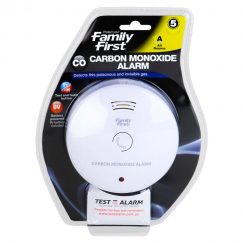What is carbon monoxide and is it dangerous?
Question
What is carbon monoxide (CO)? Is it dangerous for my health?
Answer
Carbon monoxide can be produced by gas or oil appliances like a furnace, clothes dryer, range, oven, water heater, or space heater. When appliances and vents work properly, and there is enough fresh air in your home to allow complete combustion, the trace amounts of carbon monoxide produced are typically not dangerous. However high levels of CO can be deadly.
These situations can cause carbon monoxide levels to rise quickly:
- Appliance malfunction, i.e. the heat exchanger on your furnace cracks.
- Vent, flue, or chimney is blocked by debris or even snow.
- Fireplace, wood burning stove or charcoal grill is not properly vented.
- Vehicle is left running in an attached garage and CO seeps into the house.
- Several appliances are running at the same time, competing for limited fresh air. This can cause incomplete combustion and produce CO, even if all appliances are in good working condition.
- Using a cooking or heating appliance indoors that is meant only to be used outdoors with proper ventilation.
Health effects
Carbon monoxide robs your blood of oxygen. When you inhale carbon monoxide, it bonds with the haemoglobin in your blood, displacing life-giving oxygen. This produces a toxic compound in your blood called carboxyhaemoglobin (COHb).
Over time, exposure to carbon monoxide can make you sick. Victims exposed to enough carbon monoxide can suffer brain damage, or even die.
According to the Journal of the American Medical Association, 1500 people die each year because of CO poisoning, and another 10,000 become ill. Since you can’t see, smell, or taste carbon monoxide, it can make you sick before you even know it is there.
Important safety tips
These are some essential safety measures you must follow to be safe with gas and the risk of carbon monoxide:
- Never use outdoor cooking or heating equipment inside or in enclosed areas – including tents, caravans or next to your vehicle.
- Ensure good ventilation when using gas appliances.
- Do not leaving heating equipment on overnight.
- Do not use exhaust fans at the same time as using gas heaters.
- Use qualified technicians (for Type A Appliance Servicing work) to have your gas-powered heating and cooking equipment inspected every two years.
- Never leave your car running in an enclosed area.
- Install a carbon monoxide alarm – but remember that they are not smoke alarms, you must have them too!
